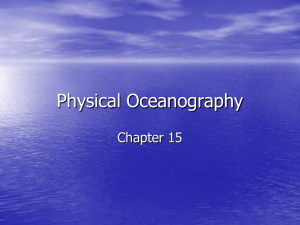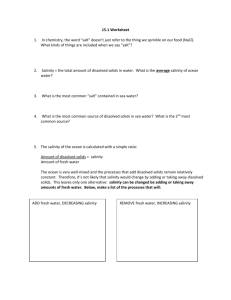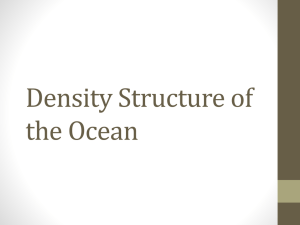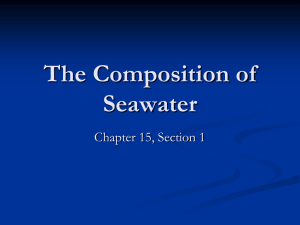this worksheet - e-Education Institute
advertisement
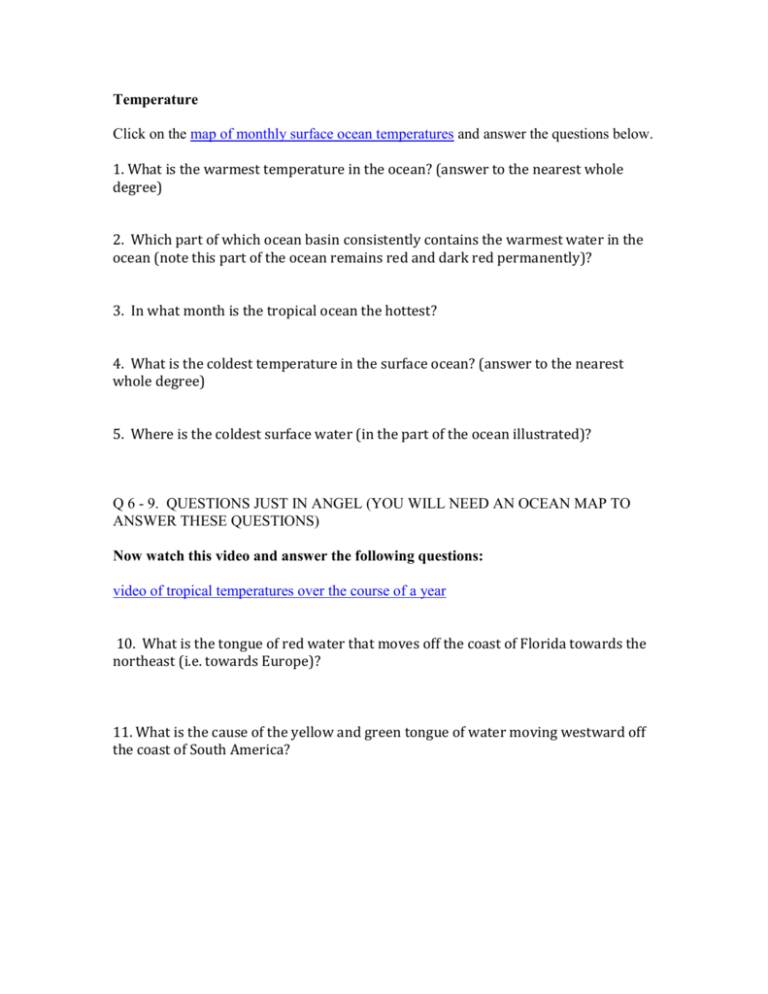
Temperature Click on the map of monthly surface ocean temperatures and answer the questions below. 1. What is the warmest temperature in the ocean? (answer to the nearest whole degree) 2. Which part of which ocean basin consistently contains the warmest water in the ocean (note this part of the ocean remains red and dark red permanently)? 3. In what month is the tropical ocean the hottest? 4. What is the coldest temperature in the surface ocean? (answer to the nearest whole degree) 5. Where is the coldest surface water (in the part of the ocean illustrated)? Q 6 - 9. QUESTIONS JUST IN ANGEL (YOU WILL NEED AN OCEAN MAP TO ANSWER THESE QUESTIONS) Now watch this video and answer the following questions: video of tropical temperatures over the course of a year 10. What is the tongue of red water that moves off the coast of Florida towards the northeast (i.e. towards Europe)? 11. What is the cause of the yellow and green tongue of water moving westward off the coast of South America? Salinity Here is a figure that shows the global salinity variations. Look at it and answer the following questions: Salinity variation in the global ocean Credit: http://en.wikipedia.org/wiki/Salinity (link is external) 12. Where is the saltiest water in the ocean (hint: it is not in a major ocean basin)? Why (think about the processes that impact surface ocean salinity? 13. What locations are characterized by the freshest water in the Atlantic Ocean? Why (think about the processes that impact surface ocean salinity)? 14. Are equatorial locations generally associated with fresher or saltier water? Why (again think about the processes that impact surface ocean salinity)? 15. IN ANGEL ONLY Density As we have seen, temperature and salinity combine to determine the density of a water mass. Look at this map of ocean density and answer the following questions. 16. In what locations is the lightest water in the oceans found? Why (think about the processes that impact the density of a water mass)? 17. In the northern hemisphere what locations is the highest density in the oceans found? Why (think about the processes that impact the density of a water mass)? 18. ONLY IN ANGEL Nutrients Look at the map of Chlorophyll concentration (actually the measurement is global phytoplankton distribution and photosynthetic activity which is a function of surface nutrient content) and answer the questions below. 19. Where are the highest nutrient levels found in the Northern Hemisphere? Why (think about the processes that impact the nutrient content of a surface water mass)? 20. Where are the lowest nutrient levels found? Why (think about the processes that impact the nutrient content of a surface water mass)? Deep water properties 21. Calculate the density of the water masses off the coast of Florida with a temperature of 24oC and a salinity of 35 ppt and off the coast of Norway (temperature of 8oC and salinity of 35 ppt). Make sure to record your values for temperature and salinity. You can use Water Density Calculator (link is external) for the density calculation. Temperature values can be entered directly. Salinity values are in parts per thousand and must be converted to parts per million before entry (you will get wrong answers if you don't!).(Answer to 3 decimal places e.g. 1.234) 22. Which of the locations has the highest density and is therefore the most likely to form deep water? (type the name of the place i.e. Florida or Norway) 23. Is this result what you expected from what you have learned about deep water circulation? 24. ANGEL QUESTION ONLY
